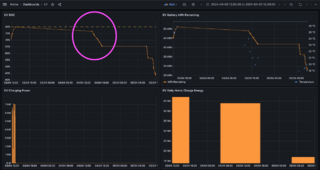Yesterday I conducted another experiment with the V2L.
It was a dismal day, not much solar to recharge the home battery but the previous days the car had been charged up with solar and also some free energy (we get 4 hours/week of free energy from the utility).
So I thought it was a good opportunity to test using the V2L to provide a steady charge to the home battery.
Parked the car near where the battery is located:
Having the rear tucked under the eave meant the charge port was afforded some protection from the elements, not that it matters a lot. V2L adapter plugged in:
Had it connected a spare cheap AIO inverter/charger and using it as an AC charger only.
After a bit of playing with the settings I settled on using a 30A (DC) charge rate, which is something over 1500 W.
I started the session some time after lunch (~1:30-2PM) at let it run until a bit after 6PM. The battery at the start of the session reported a SOC of 80% / 51.2 kWh. It finished at 6:10 PM with 65.4% / 41.8 kWh.
So I pulled 9.4 kWh from the car's battery over the course of the afternoon, which is about 55 km of highway range.
Using the new Home Assistant integration for the MG4 I was able to monitor the progress. It took me a little while to get that automated but the system will now collect the data during discharge sessions:

The circled section is showing the SOC decline during the test. I didn't manage to get the data collection working until a while into the test but it had started at 80% SOC.
Unfortunately I had wired up the AIO charger's negative terminal to the wrong side of my home battery's main shunt, so while it was charging the battery just fine, the supplemental charging data wasn't being captured by the shunt. Oops. That threw out my home battery's SOC measurements so I had to do some manual adjustments through the course of the day. I will fix that before next time and have the charger connected to the correct side of the shunt.
I took some spot readings, and while the the car reported delivering 1.767 kW, the DC charge going into our home battery (measured with a clamp meter) was 29.5A x 53.3 V = 1.572 kW, so 90% efficiency through my AIO/charger. That's actually not too bad considering it's EV DC -> EV's onboard inverter AC output -> AIO charger controller -> DC into battery.
We have a day-long grid outage coming up in a couple of weeks as the utility is repairing some power poles on/near my block, so I wanted to have a reasonable length test of the system. Without grid power, our PV supply is cut back from 13.2 kW to 2.2 kW. So using the EV to provide a steady base level of charge into the battery will help make up for the loss of supply. I can pre-charge the EV with dirt cheap energy in the days beforehand. If they want to give me free energy, I may as well make good use of it!